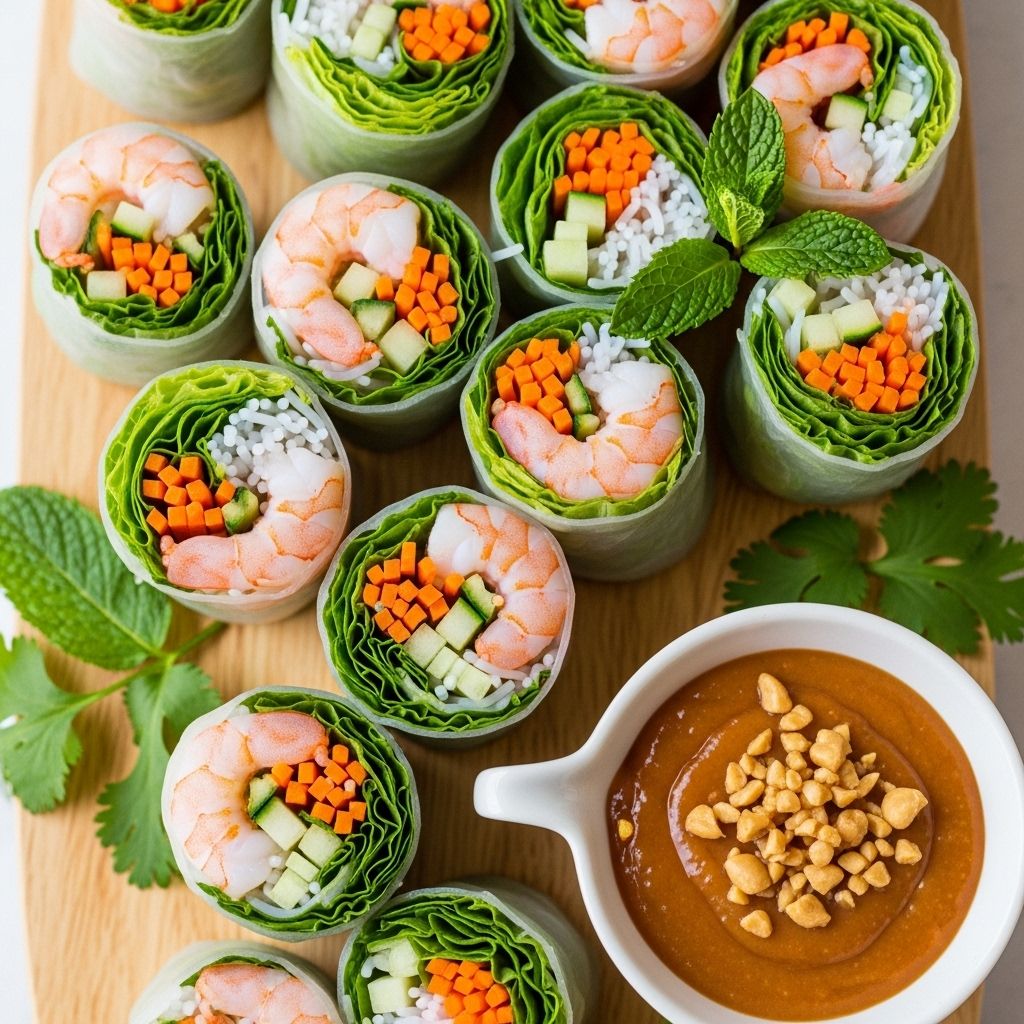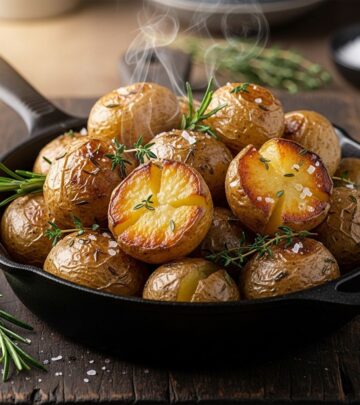Fresh Spring Rolls Recipe: A Step-by-Step Guide to Perfect Homemade Rolls
Discover a foolproof rolling method that highlights colorful veggies and zesty shrimp.

There’s something uniquely satisfying about biting into a homemade spring roll: the crisp, fresh vegetables, sweet mango, fragrant herbs, and tender shrimp all delicately wrapped in translucent rice paper. Paired with a creamy peanut dipping sauce, these spring rolls are as stunning as they are delicious. Whether served as an appetizer, light lunch, or a party snack, spring rolls are endlessly versatile and customizable to your tastes. This detailed guide will walk you through every aspect of preparing spring rolls at home, mirroring the flavors and techniques of classic Vietnamese rolls.
What Are Spring Rolls?
Spring rolls, sometimes known as gỏi cuốn in Vietnamese cuisine, are a popular fresh appetizer consisting of rice paper wrappers encasing a medley of crisp vegetables, vermicelli rice noodles, shrimp (or other proteins), and aromatic herbs. Unlike the deep-fried variety, these rolls are not cooked after assembly, letting the natural flavors and crunch of the ingredients shine. Traditionally served at room temperature, they’re often accompanied by flavorful dipping sauces, with peanut and sweet chili sauce being favorites.
Spring Roll Ingredients
Building the perfect spring roll begins with gathering the right ingredients. Here’s what you’ll need for the classic shrimp and veggie version. Feel free to swap or add items based on your preferences or whatever’s fresh in your market.
For the Spring Rolls:
- 4 oz. vermicelli rice noodles
- 1 (4.7-oz.) package Vietnamese spring roll wrappers (about 16 wrappers)
- 1/2 head butter lettuce, leaves torn in half
- 2 large carrots, julienned (about 1 cup)
- 1/2 English cucumber, thinly sliced (about 1 cup)
- 1 ripe mango, thinly sliced
- 6 green onions, thinly sliced
- 2 cups mixed fresh herbs (such as basil, cilantro, mint)
- 1/2 lb. cooked medium shrimp, peeled, deveined, and cut lengthwise
- Sweet chili sauce, for serving
For the Peanut Dipping Sauce:
- 1/3 cup creamy peanut butter
- 1/4 cup hot water
- 2 Tbsp. fresh lime juice
- 2 tsp. honey
- 1 tsp. hot sauce (such as Sriracha), to taste
- 1 tsp. toasted sesame oil
- 1 tsp. soy sauce
- 1 garlic clove, finely grated
- Chopped roasted peanuts, for garnish (optional)
How to Make Fresh Spring Rolls: Step-by-Step Directions
Making spring rolls at home is surprisingly simple with just a few techniques. Here’s a step-by-step process to assemble perfect rolls.
- Cook the Rice Noodles: Prepare the vermicelli noodles following package instructions. Usually, this involves soaking them briefly in hot water, then draining well and letting them cool.
- Prep the Fillings: Slice the vegetables (carrot, cucumber, mango, green onion) into thin matchsticks or strips for easy rolling. Tear the lettuce leaves and prepare the herbs and shrimp.
- Soften the Rice Paper: Pour warm water into a wide, shallow dish or pie plate. Working with one wrapper at a time, dip it into the warm water for about 5–10 seconds. Remove once softened but still slightly firm—the paper will continue to soften as you work.
- Assemble the Rolls: Place the softened wrapper on a damp cutting board or clean kitchen towel. On the lower third of the wrapper, arrange a few pieces of lettuce, a small bundle of noodles, carrot, cucumber, mango, green onion, and plenty of fresh herbs. Top with 3–4 pieces of shrimp.
- Roll it Up: Fold the bottom of the wrapper snugly over the fillings. Fold in the sides, then continue to tightly roll up from the bottom, tucking as you go. The roll should be compact but not so tight that the wrapper tears.
- Repeat: Place finished rolls on a platter and cover with a damp paper towel to prevent drying out. Repeat the process with the remaining ingredients.
- Make the Peanut Sauce: In a bowl, whisk together peanut butter, hot water, lime juice, honey, hot sauce, sesame oil, soy sauce, and garlic until smooth. Top with chopped peanuts if desired and transfer to a serving bowl.
- Serve: Plate the spring rolls with bowls of peanut sauce and sweet chili sauce for dipping.
Ingredient Tips and Substitutions
- Noodles: Vermicelli rice noodles are preferred for their texture, but cellophane noodles (bean thread noodles) make a fine substitute.
- Protein: In place of shrimp, try cooked shredded chicken, turkey (perfect for leftovers), tofu for a vegetarian option, or omit for a plant-based roll.
- Herbs: Use any combination of basil, cilantro, and mint for authentic flavor.
- Vegetables: Buy pre-cut matchstick vegetables if available to save time, or use bell peppers, jicama, or avocado for variety.
- Fruit: Mango adds sweet brightness, but you can substitute with papaya, apple, or omit.
- Rice Paper: Look for round, thin rice paper wrappers in the Asian section of your grocery store.
Expert Tips for Foolproof Spring Rolls
- Avoid Overfilling: Use a modest amount of filling so the wrapper will roll tightly and not burst.
- Work Quickly: Rice paper becomes sticky after softening. Work with one at a time and cover finished rolls with a damp towel.
- Keep Ingredients Dry: Excess moisture will tear wrappers or make them soggy. Pat vegetables and lettuce dry before assembling.
- Display Herbs: For a pretty effect, lay a few whole herb leaves or shrimp directly against the wrapper before filling so they show through once rolled.
Serving Suggestions
These vibrant spring rolls shine as a healthy start to a meal but double as a light entrée, party finger food, or lunchbox addition. Serve with:
- Creamy peanut dipping sauce (see recipe above)
- Sweet chili sauce for a spicy-sweet alternative
- Soy sauce with a splash of lime and chopped scallions for a lighter option
To keep rolls fresh, assemble them no more than a couple of hours ahead. Store, covered with a damp towel and plastic wrap, at room temperature. Leftovers can be kept for up to a day; the rice paper may harden slightly but will still be tasty.
Spring Rolls Table: Ingredients & Their Roles
| Ingredient | Role in Spring Rolls |
|---|---|
| Rice paper wrappers | Encases and holds all fillings, edible and slightly chewy texture |
| Vermicelli noodles | Provides a soft, springy base and binds fillings together |
| Shrimp | Offers protein and a light, briny flavor |
| Lettuce & Vegetables | Adds crunch, color, and freshness |
| Mango | Gives a sweet, juicy contrast to savory elements |
| Herbs (mint, basil, cilantro) | Lends aromatic, bright flavor notes |
| Peanut sauce | Rich, tangy dip that complements the fresh fillings |
Variations and Seasonal Twists
- Leftover Turkey or Chicken Spring Rolls: Shred leftover cooked turkey or chicken and toss it with soy sauce, sesame oil, and a splash of rice vinegar before adding to rolls.
- Vegetarian Rolls: Skip the shrimp and add slices of avocado, tofu, or extra vegetables.
- Fruit-forward Rolls: Double the mango and add thinly sliced strawberries, kiwi, or apples for a refreshing twist.
- Spicy Rolls: Add a dash of sriracha or sliced chili peppers to the filling for extra heat.
Shortcut Tips
- Pre-cut Veggies: Many grocery stores offer vegetables already cut into matchsticks or strips—ideal for quick assembly.
- Make Ahead: Prep all fillings a few hours in advance and store in airtight containers. Assemble rolls shortly before serving for maximum freshness.
- Dipping Sauce Variety: Pair your rolls with hoisin, nuoc cham (Vietnamese fish sauce dip), or tamari for gluten-free options.
Frequently Asked Questions (FAQs)
What’s the difference between spring rolls and egg rolls?
Spring rolls are typically made with rice paper wrappers and are served fresh (not fried) with crisp vegetables and herbs. Egg rolls use wheat flour wrappers and are usually deep-fried, often featuring a cooked meat or cabbage filling.
How do I keep spring rolls from sticking together?
Cover assembled rolls with a damp paper towel and arrange them in a single layer without touching, or separate layers with parchment paper if refrigerating.
Can I make spring rolls in advance?
Spring rolls taste best fresh, but you can make them a few hours ahead. Store covered with a damp towel and plastic wrap at room temperature. Avoid refrigerating, as rice paper can harden.
Are spring rolls gluten-free?
Most spring rolls are gluten-free, provided the rice paper and dipping sauces do not contain wheat-based ingredients. Always check labels for soy sauce and other condiments.
What else can I put in spring rolls?
Feel free to experiment with bell peppers, sliced radishes, cooked tofu, bean sprouts, jicama, avocado, or even seasonal greens and fruits. The assembly is endlessly customizable.
Nutrition Information (Estimated Per Roll)
- Calories: ~100–150 (varies by filling and dipping sauce)
- Fat: 2–5g
- Protein: 4–6g
- Fiber: 1–3g
- Vitamins A, C, folate from fresh vegetables and herbs
Final Thoughts: Why You’ll Love This Spring Roll Recipe
Homemade spring rolls are one of the best ways to showcase gorgeous, fresh produce and experiment with contrasting flavors and textures. Crisp, sweet, savory, and aromatic, these rolls transform everyday ingredients into bites bursting with freshness. With a little practice, you’ll roll them like a pro—making them a go-to favorite for healthy meals and entertaining alike.
References
- https://www.thepioneerwoman.com/food-cooking/recipes/a60432339/spring-rolls-recipe/
- https://www.youtube.com/watch?v=bUqZ4nVT0VQ
- https://www.thepioneerwoman.com/food-cooking/recipes/a10417/leftover-turkey-spring-rolls/
- https://www.thepioneerwoman.com/food-cooking/recipes/a93502/shrimp-spring-roll-noodle-bowls/
- https://www.youtube.com/watch?v=KAiF6Ng7H1E
Read full bio of medha deb












